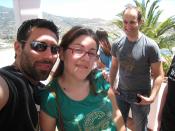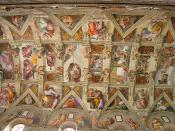The Renaissance was a 'rebirth' or renewal of many of the classical ancient Greek and Roman beliefs. The Renaissance began in the city-states of Italy, the center of trade in Europe. Many wealthy merchants and bankers became patrons of the newly developing styles and ideals of Renaissance art. Many of the renewed classical Greek and Roman ideas such as humanism, individualism, secularism, and realism were expressed through the Italian art and the artist's interests and influences of the period. These ideas can be traced through the works of Donatello, Michelangelo, and Botticelli.
Italian sculptor Donatello sculpted David, the first free-standing nude male statue since the time of the Greeks and Romans. Donatello is often associated with realism; "Realism is an attempt to describe human behavior and surroundings or to represent figures and objects exactly as they act or appear in life." Within his life span Donatello was able to apply realism to dozens of sculptures including David, Mary Magdalene, and Madonna.
A major intellectual movement of the Renaissance was humanism, a philosophy based on the idea that people are rational beings. It stressed the importance of the individual, his potential, and his achievements; this was a central idea during the Renaissance. Humanism originated in the study of the ancient Greek and Roman classics, which led to a higher interest in learning and the arts. Michelangelo, Italian painter, sculptor, architect, and poet was a humanist who followed in the footsteps of the Greeks and Romans. One of his greatest works was David, which was his version of the sculpture of the nude male. This sculpture glorified the human form, and its potential. One can truly see the extent of strain that Michelangelo put in the details in David's features; everything is in proportion, the body is masculine, and, in...


